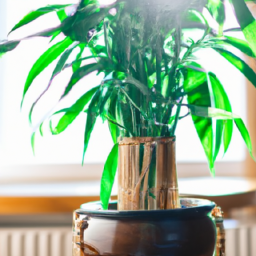
The Basics of Indoor Plant Feng Shui: Enhancing Positive Energy at Home
Introduction
Creating a harmonious and positive energy flow within your home is essential for promoting a sense of well-being and balance. Indoor plant Feng Shui is a powerful practice that can help you achieve this by harnessing the natural energy of plants. In this guide, we will explore the basics of indoor plant Feng Shui and provide you with a step-by-step approach to creating positive energy at home.
The Power of Indoor Plants
Indoor plants have been used for centuries to enhance the energy flow in living spaces. They not only add beauty and freshness to your home but also act as natural air purifiers and stress relievers. According to Feng Shui principles, plants represent the Wood element, which symbolizes growth, vitality, and new beginnings. By incorporating indoor plants strategically, you can invite positive energy and create a harmonious environment.
When selecting indoor plants for Feng Shui, it’s important to consider their specific qualities and characteristics. Some plants are known for their ability to purify the air, while others bring luck and prosperity. Understanding these attributes will help you choose the right plants for your home.
Step 1: Assessing Your Space
The first step in creating positive energy through indoor plant Feng Shui is to assess your space. Take a walk through your home and identify areas that feel stagnant or cluttered. These areas may lack sufficient natural light or have poor air circulation. By focusing on these spaces, you can target the areas that need the most energy enhancement.
Consider the size of the room and the available floor and shelf space for placing plants. Take note of any specific Feng Shui areas, such as the Wealth or Relationship corners, that could benefit from plant energy. By understanding your space, you can make informed decisions about the types and placement of indoor plants.
Step 2: Choosing the Right Plants
Once you have assessed your space, it’s time to choose the right indoor plants for your home. Here are some popular Feng Shui plants and their associated qualities:
Lucky Bamboo (Dracaena sanderiana)
Lucky Bamboo is a popular Feng Shui plant that symbolizes luck, prosperity, and resilience. It is believed to bring positive energy and good fortune to the home. Place Lucky Bamboo in the Wealth or Career areas to enhance abundance and success.
Money Tree (Pachira aquatica)
The Money Tree is another auspicious plant that is associated with wealth and prosperity. It is believed to attract good luck and financial abundance. Place the Money Tree in the Wealth corner or near the entrance to invite positive energy and opportunities.
Snake Plant (Sansevieria trifasciata)
The Snake Plant is known for its air-purifying properties and ability to absorb toxins. It is a low-maintenance plant that thrives in various lighting conditions. Place Snake Plants in bedrooms or areas with electronic devices to improve air quality and promote restful sleep.
Peace Lily (Spathiphyllum)
The Peace Lily is a beautiful plant that symbolizes peace, harmony, and purification. It has the ability to remove harmful toxins from the air, making it an excellent choice for improving indoor air quality. Place Peace Lilies in living rooms or areas where you spend a lot of time to create a serene and balanced atmosphere.
These are just a few examples of Feng Shui plants, and there are many more to explore. Choose plants that resonate with you and align with your specific intentions for each area of your home.
Step 3: Placement and Arrangement
Now that you have selected the right indoor plants, it’s time to consider their placement and arrangement. Here are some guidelines to follow:
1. Balance Yin and Yang: Yin energy is calming and passive, while Yang energy is vibrant and active. Create a balance between the two by placing Yin plants, such as Peace Lilies, in active areas and Yang plants, like Snake Plants, in more tranquil spaces.
2. Use the Bagua Map: The Bagua Map is a Feng Shui tool that divides your home into nine areas, each representing a different aspect of life. Place plants in specific areas according to their associated qualities. For example, place Lucky Bamboo in the Wealth corner and Snake Plants in the Health area.
3. Consider Size and Proportion: Choose plants that are proportionate to the size of the room. Avoid overcrowding and ensure that plants have enough space to grow and thrive. Tall plants, like the Money Tree, can be placed in corners to add height and balance to the space.
4. Pay Attention to Light and Water: Different plants have varying light and water requirements. Ensure that you place plants in areas with appropriate lighting conditions and provide them with the necessary care and maintenance. Avoid placing plants in direct sunlight or near drafts.
Conclusion
Indoor plant Feng Shui is a wonderful practice that can transform your home into a sanctuary of positive energy and balance. By selecting the right plants, assessing your space, and considering their placement and arrangement, you can create a harmonious environment that promotes well-being and prosperity. Embrace the power of indoor plants and let them enhance the positive energy in your home.
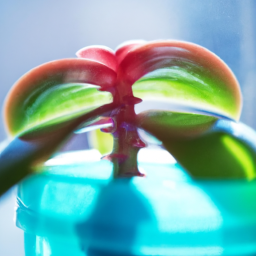
Choosing the Right Indoor Plants for Feng Shui: A Guide to Positive Energy
Introduction
Welcome to the world of Indoor Plant Feng Shui, where the art of arranging plants in your home can bring positive energy and harmony into your life. In this guide, we will explore the importance of choosing the right indoor plants for Feng Shui and how they can enhance the energy flow in your living space. By following these steps, you can create a serene and balanced environment that promotes well-being and prosperity.
Understanding the Basics of Indoor Plant Feng Shui
Before we dive into selecting the perfect indoor plants, it’s essential to understand the basics of Indoor Plant Feng Shui. This ancient practice originated in China and focuses on the flow of energy, or chi, within a space. According to Feng Shui principles, plants have the power to attract and channel positive energy, while also purifying the air and creating a sense of tranquility.
By strategically placing indoor plants in specific areas of your home, you can optimize the flow of energy and invite abundance, health, and happiness into your life. Now, let’s explore the step-by-step process of choosing the right indoor plants for Feng Shui.
Step 1: Assessing Your Home’s Energy Map
The first step in selecting indoor plants for Feng Shui is to assess your home’s energy map, also known as the Bagua. The Bagua is a Feng Shui tool that divides your living space into nine areas, each representing different aspects of life such as wealth, health, relationships, and career.
Take a floor plan of your home and superimpose the Bagua grid over it. This will help you identify which areas correspond to each aspect of life. Once you have a clear understanding of your home’s energy map, you can proceed to the next step.
Step 2: Matching Plants to Bagua Areas
Now that you know the specific areas of your home that correspond to different aspects of life, it’s time to choose indoor plants that align with each Bagua area. Here are some plant suggestions for each aspect:
Wealth and Prosperity (Southeast):
Plants that symbolize abundance and wealth, such as money trees (Pachira aquatica) or jade plants (Crassula ovata), are ideal for this area. Their round, coin-shaped leaves are believed to attract financial prosperity.
Additionally, you can consider placing a bamboo plant (Dracaena sanderiana) in a glass container filled with water, as it represents the flow of money and good fortune.
Health and Family (East and Southeast):
To promote health and family harmony, choose plants with lush, vibrant foliage. Examples include peace lilies (Spathiphyllum), snake plants (Sansevieria), or philodendrons (Philodendron spp.). These plants purify the air and create a calming atmosphere, ideal for fostering good health and strong relationships.
Love and Relationships (Southwest):
In the Southwest area of your home, focus on plants that symbolize love and romance. Consider flowering plants like orchids, roses, or jasmine, as they evoke feelings of passion and desire. Place them in pairs to enhance the energy of love and strengthen relationships.
Career and Success (North):
To enhance your career and promote success, choose plants with upward growth patterns, such as lucky bamboo (Dracaena sanderiana) or rubber plants (Ficus elastica). These plants symbolize growth, resilience, and upward mobility, making them perfect for the North area of your home.
Step 3: Considering Light and Water Requirements
While selecting indoor plants for Feng Shui, it is crucial to consider their light and water requirements. Different plants have varying needs, and it’s essential to provide them with the right conditions to thrive.
For areas with bright, indirect light, consider plants like pothos (Epipremnum aureum), spider plants (Chlorophytum comosum), or ZZ plants (Zamioculcas zamiifolia). These plants can tolerate lower light levels and are perfect for spaces with limited sunlight.
On the other hand, if you have areas with abundant natural light, consider plants like succulents or cacti. These plants thrive in bright, sunny conditions and can bring vibrant energy to your space.
Remember to water your plants regularly, but avoid overwatering as it can lead to root rot. Each plant has different water requirements, so ensure you understand the needs of each species and water accordingly.
Conclusion
By following these steps and choosing the right indoor plants for Feng Shui, you can create a harmonious and energetically balanced home. Remember to assess your home’s energy map, match plants to specific Bagua areas, and consider their light and water requirements. With the right indoor plants, you can invite positive energy, abundance, and well-being into your life, creating a sanctuary of tranquility and prosperity.
Embrace the power of Indoor Plant Feng Shui and watch as your living space transforms into a haven of positive energy and vibrant growth.
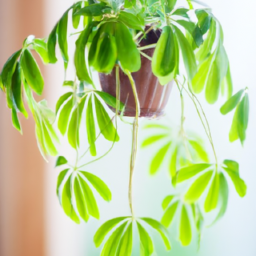
Arranging Indoor Plants for Feng Shui: Optimizing Positive Energy Flow
Indoor plants not only bring a touch of nature into our homes but also play a significant role in enhancing the positive energy flow, known as Qi, according to the principles of Feng Shui. By strategically placing plants in specific areas, we can create a harmonious environment that promotes well-being, balance, and prosperity. In this guide, we will explore the art of arranging indoor plants for Feng Shui and how it can optimize the positive energy flow in your home.
1. Understanding the Basics of Feng Shui
Before delving into the arrangement of indoor plants, it is essential to have a basic understanding of Feng Shui principles. Feng Shui is an ancient Chinese practice that focuses on creating a harmonious balance between individuals and their surroundings. It emphasizes the flow of energy, or Qi, and how it can influence various aspects of our lives, including health, relationships, and success.
According to Feng Shui, each area of our home corresponds to different aspects of our life. By arranging indoor plants in specific areas, we can enhance the energy associated with those aspects. The Bagua map, a tool used in Feng Shui, divides our living space into nine areas, each representing different aspects such as wealth, love, health, and career.
Now that we have a basic understanding of Feng Shui principles, let’s explore how to arrange indoor plants to optimize positive energy flow.
2. Choosing the Right Indoor Plants
The first step in arranging indoor plants for Feng Shui is selecting the right plants. Certain plants are considered more auspicious and bring positive energy into our homes. Here are a few popular choices:
Lucky Bamboo (Dracaena sanderiana): This plant is believed to bring good luck, wealth, and prosperity. It is often placed in the wealth area of the Bagua map.
Jade Plant (Crassula ovata): Known as the money plant, the Jade plant symbolizes financial success and growth. It is commonly placed near the entrance or in the wealth area.
Peace Lily (Spathiphyllum): The Peace Lily is known for its air-purifying properties and ability to promote tranquility. It is suitable for various areas, including the bedroom and meditation space.
Snake Plant (Sansevieria trifasciata): Also known as the mother-in-law’s tongue, the Snake Plant is believed to absorb negative energy and promote positive vibes. It is ideal for areas with electronic devices, such as the office or living room.
Money Tree (Pachira aquatica): As the name suggests, the Money Tree is associated with wealth and abundance. It is often placed in the wealth area or near the entrance.
3. Placement of Indoor Plants
Now that we have chosen the right indoor plants, let’s explore their optimal placement for maximizing positive energy flow:
1. Wealth Area (Southeast): Place plants that symbolize abundance, such as the Money Tree or Lucky Bamboo, in this area to attract wealth and prosperity.
2. Love and Relationship Area (Southwest): Enhance the energy of love and relationships by placing plants with heart-shaped leaves, such as the Philodendron, in this area.
3. Health Area (East): Promote good health and well-being by placing air-purifying plants like the Peace Lily or Areca Palm in this area.
4. Career Area (North): Stimulate career growth and success by placing plants with upward growth, such as the Snake Plant or Dracaena, in this area.
5. Knowledge Area (Northeast): Foster learning and personal growth by placing plants with vibrant green leaves, like the Pothos or Spider Plant, in this area.
6. Fame and Reputation Area (South): Boost your reputation and recognition by placing plants with red or purple flowers, such as the Anthurium or Orchid, in this area.
7. Family Area (East or Southeast): Strengthen family bonds and harmony by placing plants with rounded leaves, such as the Rubber Plant or Ficus, in this area.
8. Creativity Area (West): Enhance creativity and inspiration by placing flowering plants, such as the African Violet or Gerbera Daisy, in this area.
9. Helpful People Area (Northwest): Attract supportive and helpful people into your life by placing plants with white or metallic leaves, such as the Silver Pothos or Aluminum Plant, in this area.
Remember to regularly care for your indoor plants by providing them with adequate sunlight, water, and nutrients. Healthy plants radiate positive energy and contribute to a harmonious environment.
By following these steps and understanding the principles of Feng Shui, you can create a positive energy flow in your home through the strategic arrangement of indoor plants. Embrace the beauty of nature and let it harmonize your living space, promoting well-being, balance, and prosperity.
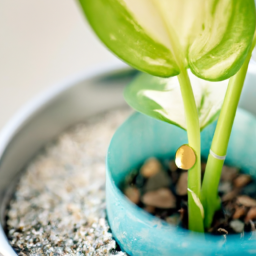
Common Indoor Plant Feng Shui Mistakes to Avoid: Maintaining Harmonious Energy
Introduction
Indoor plants have long been recognized for their ability to enhance the overall energy and ambiance of a space. When it comes to Feng Shui, the ancient Chinese art of harmonizing individuals with their environment, indoor plants play a crucial role in creating positive energy at home. However, it is important to be aware of common mistakes that can disrupt the harmonious flow of energy. In this article, we will explore four common indoor plant Feng Shui mistakes to avoid, ensuring that you maintain a balanced and positive atmosphere in your home.
1. Placing Plants in Inauspicious Areas
One of the most common mistakes people make when incorporating indoor plants into their Feng Shui design is placing them in inauspicious areas. In Feng Shui, each area of a home is associated with a specific element and has its own energy. Placing plants in areas that clash with their natural element can create disharmony and disrupt the flow of positive energy.
For example, placing a water-loving plant in the fire element area, such as the south, can lead to conflicts and imbalance. Similarly, placing a plant that thrives in bright light in a dark and stagnant corner can hinder its growth and vitality. To avoid these mistakes, it is important to understand the elemental qualities of both your plants and the areas of your home where you intend to place them.
2. Neglecting Plant Maintenance
Another common mistake in indoor plant Feng Shui is neglecting plant maintenance. Just like any living being, plants require care and attention to thrive and radiate positive energy. Neglecting their needs can lead to withering, stagnant energy, and even attract negative energy into your home.
Regularly watering, pruning, and cleaning your plants are essential for their well-being. Overwatering or underwatering can disrupt the balance of energy, causing the plant to suffer. Additionally, removing dead leaves and keeping the plant clean not only enhances its appearance but also ensures the flow of positive energy. Remember to also periodically rotate your plants to ensure equal exposure to light and prevent them from leaning towards a specific direction.
3. Using Artificial Plants
While artificial plants may seem like an easy solution for those lacking a green thumb, they can be detrimental to the harmonious energy of your home. Feng Shui emphasizes the importance of connecting with nature and incorporating living elements into your space. Artificial plants lack the life force and vitality that real plants possess, and their stagnant energy can disrupt the flow of positive energy in your home.
If you are unable to care for real plants, consider opting for low-maintenance varieties that require minimal attention. There are plenty of options available, such as succulents or snake plants, which thrive in various conditions and are known for their air-purifying properties. By choosing living plants over artificial ones, you invite vibrant energy and a deeper connection with nature into your home.
4. Cluttering with Too Many Plants
While indoor plants are excellent for promoting positive energy, it is important not to go overboard and clutter your space with too many plants. In Feng Shui, clutter disrupts the flow of energy and creates stagnant areas that hinder the overall balance and harmony of the space.
Instead of scattering plants randomly throughout your home, consider strategically placing them in areas where they can have the most impact. For example, placing a plant near the entrance can invite positive energy into your home, while incorporating plants in the wealth area can enhance abundance and prosperity. By carefully selecting the number and placement of your indoor plants, you can create a harmonious and balanced environment.
Conclusion
Incorporating indoor plants into your home is an excellent way to enhance the positive energy and create a harmonious atmosphere. However, it is crucial to avoid common indoor plant Feng Shui mistakes that can disrupt the flow of energy. By placing plants in auspicious areas, maintaining their well-being, choosing real plants over artificial ones, and avoiding clutter, you can ensure that your indoor plants contribute to a balanced and positive energy in your home. Embrace the power of indoor plant Feng Shui and enjoy the benefits of a harmonious living space.
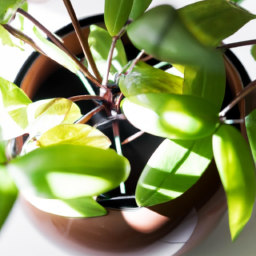
The Benefits of Indoor Plant Feng Shui: Creating a Calm and Positive Home Environment
Indoor plants not only add beauty to our homes but also have a profound impact on our overall well-being. Incorporating the principles of Feng Shui into the arrangement of indoor plants can further enhance the positive energy and create a calm and harmonious environment. In this article, we will explore the benefits of indoor plant Feng Shui and provide you with a step-by-step guide to create positive energy at home.
1. Enhancing Air Quality and Health
Indoor plants are natural air purifiers, filtering out harmful toxins and releasing oxygen into the air. By strategically placing plants throughout your home, you can improve the air quality and create a healthier living space. According to Feng Shui principles, certain plants have specific properties that can enhance different aspects of your life.
For example, the Snake Plant (Sansevieria) is known for its ability to absorb toxins and release oxygen at night, making it an ideal choice for bedrooms. The Peace Lily (Spathiphyllum) not only purifies the air but also brings a sense of calm and tranquility to any room. The Money Plant (Epipremnum aureum) is believed to attract wealth and good luck when placed in the wealth corner of your home.
To create a positive energy flow, choose plants with rounded and soft leaves as they are considered more soothing and gentle. Avoid plants with sharp or spiky leaves, as they may disrupt the flow of energy.
2. Boosting Productivity and Concentration
Indoor plants can have a significant impact on our productivity and concentration levels. Studies have shown that having plants in the workplace or study area can improve focus, reduce stress, and increase overall well-being.
According to Feng Shui principles, placing plants such as the Bamboo Palm (Chamaedorea seifrizii) or the Areca Palm (Dypsis lutescens) near your workspace can enhance creativity and promote a sense of calm. These plants are known for their ability to purify the air and create a serene atmosphere, allowing you to concentrate better on your tasks.
When arranging plants in your workspace, consider the Bagua map, a Feng Shui tool that divides your space into nine areas, each representing a different aspect of life. Placing plants in the wealth or career area can help boost financial success and professional growth.
3. Creating a Relaxing and Restful Bedroom
Your bedroom should be a sanctuary for rest and relaxation. By incorporating indoor plants into your bedroom design, you can create a soothing and peaceful atmosphere that promotes a good night’s sleep.
According to Feng Shui principles, plants with gentle and calming energy, such as the Lavender Plant (Lavandula) or the Aloe Vera Plant (Aloe barbadensis), are ideal choices for the bedroom. These plants not only purify the air but also emit a pleasant fragrance that can help you unwind and de-stress.
When placing plants in your bedroom, avoid plants that release excessive amounts of oxygen at night, as they may disrupt your sleep. Additionally, it is recommended to keep electronics and work-related items out of the bedroom to create a more serene environment.
By following these steps and incorporating indoor plants into your home using the principles of Feng Shui, you can create a calm and positive environment that promotes overall well-being and harmony.
Frequently Asked Questions (FAQ)
1. What is Feng Shui?
Feng Shui is an ancient Chinese practice that focuses on harmonizing and balancing the energy flow in a space to promote well-being and positive energy.
2. How can indoor plants enhance Feng Shui in my home?
Indoor plants are believed to bring vibrant energy and improve air quality, making them an excellent addition to enhance the Feng Shui of your home.
3. Which indoor plants are best for improving Feng Shui?
Some popular indoor plants that are known to improve Feng Shui include the money plant, peace lily, snake plant, bamboo palm, and jade plant.
4. Where should I place indoor plants for optimal Feng Shui?
It is recommended to place indoor plants in areas where the energy flow is stagnant or lacking, such as corners or spaces with poor natural light. Avoid placing them in bedrooms or areas with excessive Yin energy.
5. How many indoor plants should I have for good Feng Shui?
The number of indoor plants you should have depends on the size of your space. It’s best to have a balanced distribution throughout your home, ensuring each area receives the positive energy from plants.
6. Can I place indoor plants in the bathroom for Feng Shui?
Yes, you can place indoor plants in the bathroom to improve Feng Shui. Choose plants that thrive in humid environments, such as ferns or orchids.
7. Are artificial plants suitable for Feng Shui?
While live plants are preferred for Feng Shui, high-quality artificial plants can be used if caring for live plants is challenging. Ensure they appear realistic and vibrant to maintain positive energy.
8. How do I care for indoor plants to maintain good Feng Shui?
To maintain good Feng Shui, ensure your indoor plants receive adequate light, water, and regular maintenance. Remove any dead or withered leaves promptly.
9. Can I use cacti or succulents for indoor Feng Shui?
Cacti and succulents are not commonly recommended for indoor Feng Shui as they emit strong Yang energy, which may disrupt the desired balance. It’s best to choose plants with softer energy.
10. Are there any indoor plants that bring wealth and prosperity according to Feng Shui?
According to Feng Shui beliefs, plants like the money plant (Pachira aquatica) and jade plant (Crassula ovata) are believed to attract wealth and prosperity when placed in the southeast or wealth area of your home.
Emily Bloomfield is an interior designer and horticulturist specializing in incorporating indoor plants into interior spaces. With a background in both design and plant science, Emily offers a unique perspective on creating harmonious living environments through the synergy of greenery and aesthetics. Her creative ideas and innovative solutions make her a sought-after authority in the field.


